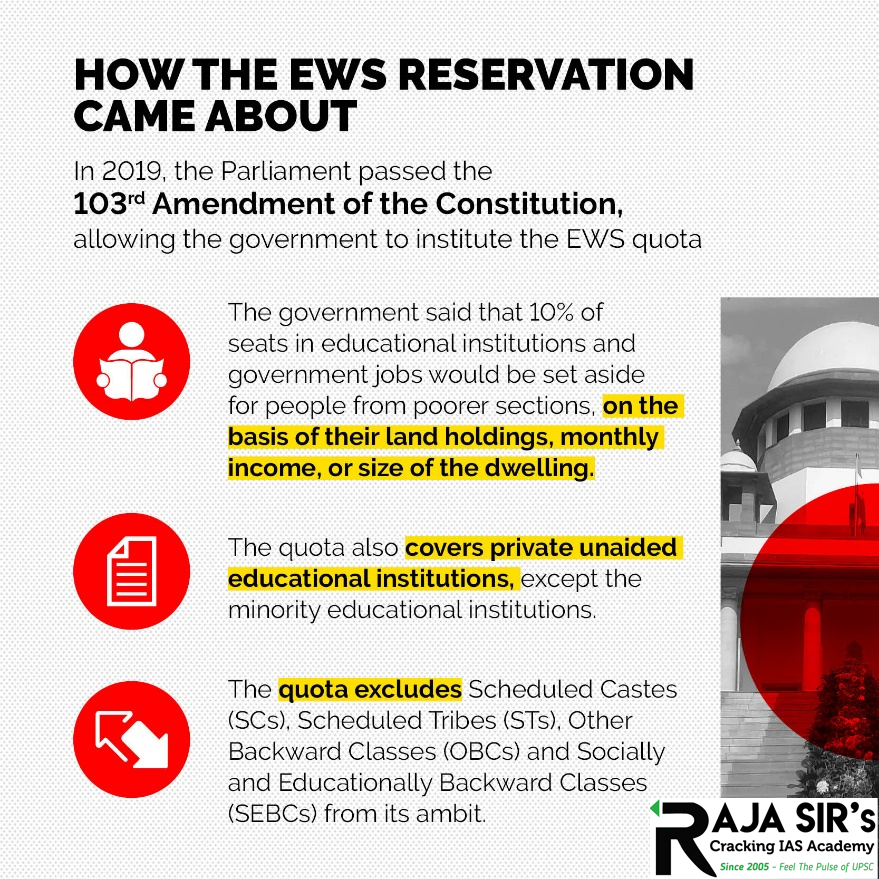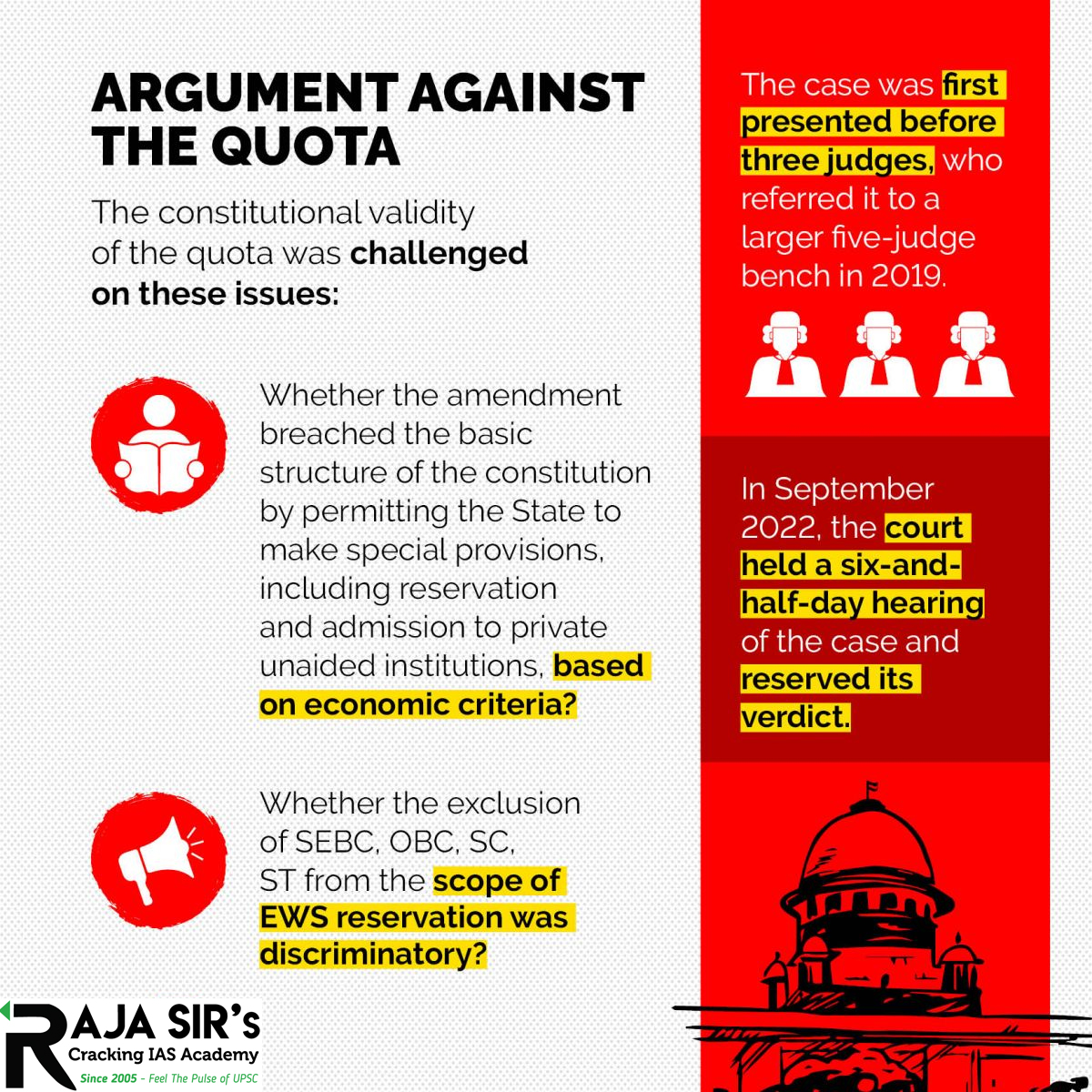- Home
- Prelims
- Mains
- Current Affairs
- Study Materials
- Test Series
The perils of undoing the framework of reservation
- From last two decades, India has witnessed growth without proper employment and increased economic insecurity.
- All India Debt & Investment Survey (AIDIS-2019) survey of 2021 shows the trend of increasing caste inequality for wealth in India.
- AIDIS collects information of- land, livestock, buildings, agricultural machinery, transport equipment, shares, deposits and amount receivable by the household.
- About 55% wealth in top quintile is controlled by upper castes followed by 36% OBCs, 5% SCs and 3% tribals.
- Due to such inequalities, 103rd Constitutional Amendment Act had introduced 10% reservation for the economically weaker sections (EWS) in education and employment among those groups that do not come under any community-based reservation.
- The decision was based on the principle that each individual regardless of caste and ethnicity should get their share of welfare entitlement.
- However, concerns have been raised on whether such benefits should be given to a specific community based on their economic backwardness.
- Such caste neutral policy can reverse positive changes brought by caste-based reservation so far.

Concerns over the EWS ruling
- Disadvantage experienced by some groups are unique to them and their deprivations require specific resolutions.
- Thus, reservation should not solely be based on economic criteria like in EWS.
- Group-based differences in economic and social conditions are inherited and not due to difference in ambition, ability and effort.
- These inherited inequalities- economic, cultural and social capital are passed to successive generations.
- This leads to intergenerational inequality of wealth prominently among caste.

How does wealth inequality is inherited in India?
- Inequality on caste- basis was rising in India between 1990 and 2020 particularly in the early 2000s.
- This was severe in the case of wealth, followed by income and consumption inequality.
- Gini index of wealth inequality has rose from 0.62 in 1992, 0.63 in 2002 and 0.67 in 2012 to 0.68 in 2019.
- It is in contrast with available consumption of 0.37 and income of 0.54 in 2012.
- Gini index-is a measure of income inequality ranging from 0(perfect equality) to 1(perfect inequality).
- Average per capita of wealth among upper castes was ₹8,03,977 in 2019 against ₹4,09,792 for OBCs, ₹2,28,388 for Dalits and ₹2,32,349 for tribals.
- On average, the upper castes own more wealth than thrice of Dalits and twice of OBCs.
- They hold 45% of the total wealth of country followed by OBCs holding 40%, Dalits 10% and Adivasis 5%.
- It is not income or saving behaviours of individuals that have generated wealth inequality but it is due to historical institutional exclusion of certain caste groups.
- If we disaggregate wealth, then land and building constitute large part of it- 60% and 22%. Respectively, which is then followed by 7% financial assets.
- Land and buildings are mostly inherited.
- The land inequality started from British colonial era.
- Colonial intervention assigned land ownership to some castes at expense of others.
- This was continued in post-colonial India.
- India’s land reform did not alter this legacy.
- The real estate boom post 1990s helped owners of land and buildings to consolidate their wealth as land value increased due to speculation.
- According to World Inequality Report 2022- Ratio of private wealth to national income increased from 290% in 1980 to 555% in 2020.
- This was fastest increase in the world.
- This was because India has zero taxation on wealth and inheritance.
Challenges in current policies
- Caste-neutral policy such as EWS ruling promotes inequality.
- Such policies cannot address the historical legacies of inequalities.
- They are insufficient to decrease magnitude of caste gap in wealth.
- Reservations are singular policy instrument to address caste-based inequality in India.
- Despite achievements in improving access to education, jobs and enhanced earnings, it failed to address structural inequalities.
- Improvement in education and access to jobs through EWS quota alone will not decrease gap of generational wealth.
- Reversing existing framework of reservation by substituting caste with economic criteria will reverse gain made so far and will increase structural inequality.
Global experience
- Loss of social and cultural status has caused anxieties among middle classes are increasing in many countries where affirmative action has taken place.
- In United States gains brought by affirmative action for Black Americans had received ‘White backlash’ or ‘White rage’.
- It is similar to anti-reservation action by introducing the EWS quota in India.
- It is not able to withstand differences in histories of caste and race- both are durable institutions of inequality.
- Legacies of these institutions will raise demand for neutral policies like caste-neutral policy in India.
Summing up
Emergence of opinion for a social policy based on universal basis of deprivation on the basis of economic backwardness will increase already existing inequalities. This degree of inequality in any society is a political choice. A just society requires creating a level-playing field that alters legacy of inherited wealth and caste that block life opportunities and choices.









 Latest News
Latest News

 General Studies
General Studies